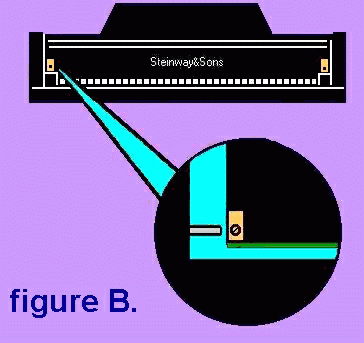 Fortunately, retrieval of these fallen objects is fairly easy on most modern grand piano models such as Yahama, Samick, Kawi, Young Chang, Steinway and Sons, Baldwin, and some others.
Fortunately, retrieval of these fallen objects is fairly easy on most modern grand piano models such as Yahama, Samick, Kawi, Young Chang, Steinway and Sons, Baldwin, and some others.
The cross section drawing in figure A of a grand piano shows how the grand FALLBOARD (the cabinet part with the maker's name on it that drops down over the keyboard) creates a kind of natural chute directly into the action for pens, pencils, small toys and about anything else that might be setting on the music rack. Fortunately, retrieval of these fallen objects is fairly easy on most modern grand piano models such as Yahama, Samick, Kawi, Young Chang, Steinway and Sons, Baldwin, and some others.
Fortunately, retrieval of these fallen objects is fairly easy on most modern grand piano models such as Yahama, Samick, Kawi, Young Chang, Steinway and Sons, Baldwin, and some others.
As shown in these illustrations, the fallboard sets on metal pins inserted into the cabinet on either end of the keyboard. The inset in figure A shows the metal bracket attached to the edge of the fallboard....the whole fallboard pivots on these pins and brackets, so as to be raised or lower over the keyboard at your whim. In most cases it should lift easily up and out. On some models there is a small set screw that holds the fallboard tight on the pins, as shown in the inset of figure B. If so, you'll need to loosen the set screws with a small screwdriver. In either case, just grip the top of the fallboard and lift it off the pins and out of the way (some can be pretty heavy so be ready to set it down someplace other than your toes). With the fallboard removed you'll be able to see directly into the action and you may be amazed, delighted or disgusted at what you find has dropped in there, especially if you have small children. After retrieving the junk, replace the fallboard by aligning the brackets on the pins and setting it back into place. Raise and lower it once or twice just to make sure it's resting on the pins correctly.
With the fallboard removed you'll be able to see directly into the action and you may be amazed, delighted or disgusted at what you find has dropped in there, especially if you have small children. After retrieving the junk, replace the fallboard by aligning the brackets on the pins and setting it back into place. Raise and lower it once or twice just to make sure it's resting on the pins correctly.
Unfortunately, life is not made so easy on some older grands where the fallboard is connected to the endblocks (the blocks of wood at either end of the keyboard) and requires that both the endblocks and the keyslip (the thin strip of wood that runs horizontally in front of the keys) be removed. If you don't see the little brass plates on the ends of the fallboard (inset, figure B), then you probably have one of these older grands. The screws holding those two cabinet parts are usually underneath the piano, if you wish to venture into trying to remove them. This will require you to lie on the floor and remove all the screws that the cabinet maker happened to have in his shop at the time. This may be more effort than the average owner wants to jump into, however, though it's easy enough for your piano tuner to routinely retrieve items from the action when tuning the piano.